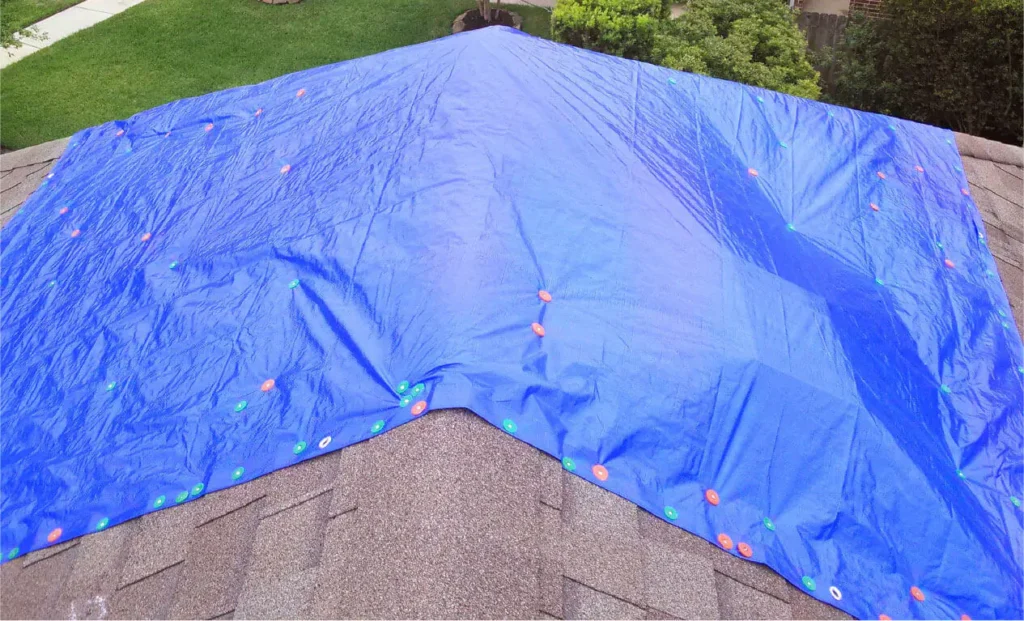Storms are wild. One minute everything’s calm, the next your roof’s leaking, shingles are missing, and the rain’s coming down like it’s got something to prove. If you’ve been through one, you know the aftermath can be just as overwhelming as the storm itself. That’s where emergency tarps come in.
They might not seem like a big deal, but emergency tarps are one of the most important tools in post-storm damage control. Whether it’s a busted roof, a shattered window, or a gaping hole in your siding, a tarp can buy you the time you need to figure out your next move—without letting more damage creep in.
So let’s talk about it. Why they matter, when to use them, and how ERX can help you cover things up—literally and figuratively.
What Is an Emergency Tarp, Anyway?
Simple answer? It’s a big, tough, waterproof sheet made to cover damaged areas of your home or business after a storm.
They’re usually made of heavy-duty plastic or canvas. The goal is to protect exposed areas from rain, wind, debris, and further damage until permanent repairs can be made.
You’ll mostly see them:
- On rooftops with missing shingles or holes
- Over broken windows or siding
- Covering vehicles or outdoor equipment
- Protecting furniture or floors from water leaks
Why Emergency Tarps Are So Important After a Storm
It’s all about buying time. Storm damage doesn’t stop once the sky clears. Wind and water love to sneak in through any weak spot and turn a small issue into a nightmare.
Here’s what an emergency tarp helps you avoid:
- Water damage to ceilings, walls, and floors
- Mold growth from soaked insulation or drywall
- Structural weakening from long-term moisture
- Higher insurance costs because the damage spread
A tarp won’t fix the problem, but it’s a solid first line of defense while you get professional repairs lined up.
When Should You Use an Emergency Tarp?
ASAP.
If your home or business has visible damage, like missing shingles, cracked windows, or siding torn off—get it covered. Even small holes in the roof can let in enough water to cause serious problems.
Here’s when it’s time to tarp:
- Right after a storm, if you notice damage
- Before another storm hits (especially if you can’t repair the first damage fast enough)
- While waiting on insurance adjusters or roofers
Basically, if there’s an opening to the outside, don’t leave it exposed.
Can I Put the Tarp Up Myself?
You can… but here’s the thing. Climbing onto your roof after a storm is risky. It could be wet, slick, or structurally unsafe.
If you’re confident and it’s a small area, sure—get up there with the right gear and secure that tarp. Use:
- Heavy-duty tarps
- 2x4s to anchor edges
- Nails, screws, or strong rope (not duct tape!)
BUT, if the damage is major or you’re not sure what you’re doing, call in pros like ERX. We’ll make sure the tarp is secured safely and correctly so it doesn’t blow away or cause more damage.
How ERX Uses Tarps in Post-Storm Restoration
At ERX, emergency tarping is one of the first things we do when we arrive at a storm-damaged property. Here’s how we help:
- Inspect the damage and look for hidden weak spots
- Secure tarps safely over vulnerable areas
- Prevent further water intrusion
- Document the damage for your insurance claim
- Create a plan for full restoration (roofing, siding, water cleanup, you name it)
We don’t just slap on a tarp and leave. We take care of everything from emergency response to full repair and restoration. Our goal? Help you protect what matters and bounce back faster.
Why You Shouldn’t Wait to Tarp After a Storm
Time is everything. Water seeps in fast and damages things you can’t always see right away—like insulation, wiring, and wood framing.
Waiting too long to tarp can mean:
- More damage
- Mold
- Higher repair costs
- Slower insurance process
And guess what? Insurance companies expect you to take “reasonable steps” to prevent further damage after a storm. Emergency tarping shows you did your part, and that can make the claims process smoother.
FAQs About Emergency Tarps After Storms
Q: How long can I leave a tarp on my roof?
A: Emergency tarps are temporary and should only be left up for a few days to a few weeks. Get permanent repairs scheduled as soon as possible.
Q: Will my insurance cover emergency tarping?
A: In many cases, yes. Most policies include coverage for temporary protective measures like tarps. ERX can provide the documentation your insurance company needs.
Q: Can I tarp during the storm?
A: Please don’t. It’s not safe. Wait until the storm passes and then assess the damage. If you need help, ERX is here 24/7.
Q: Is it better to use a pro for emergency tarping?
A: Definitely. We’ve seen tarps fly off or cause more damage because they weren’t secured properly. ERX uses industry-best practices to keep your property safe.
Q: How fast can you respond after a storm?
A: Fast. We’re available 24/7 for emergency services. Call us anytime at (866) 217-7903 and we’ll be on the way.
Conclusion: Don’t Wait—Tarp It Fast with ERX
Emergency tarps might seem simple, but they’re one of the smartest moves you can make after a storm hits. They protect your home or business, stop further damage, and help speed up recovery.
If your property took a hit during a storm, don’t wait for the next one to make it worse. Call ERX – Emergency Restoration Xperts at (866) 217-7903. We’ll be there with the right gear, the right people, and a plan to protect what matters.


